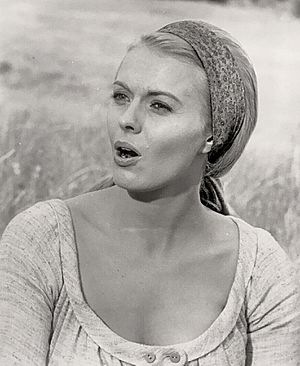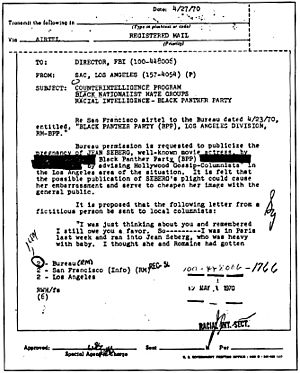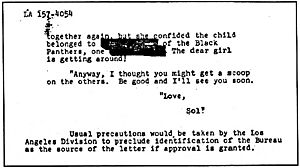Jean Seberg facts for kids
Quick facts for kids
Jean Seberg
|
|
|---|---|

Seberg in 1969
|
|
| Born |
Jean Dorothy Seberg
November 13, 1938 Marshalltown, Iowa, U.S.
|
| Died | August 30, 1979 (aged 40) Paris, France
|
| Resting place | Montparnasse Cemetery |
| Alma mater | University of Iowa |
| Occupation | Actress |
| Years active | 1957–1979 |
| Spouse(s) |
François Moreuil
(m. 1958; div. 1960)Dennis Charles Berry
(m. 1972) |
| Children | 2 (1 deceased) |
Jean Dorothy Seberg (born November 13, 1938 – died August 30, 1979) was an American actress. She spent a large part of her life living in France. She became famous for her role in the 1960 French film Breathless. This movie made her a well-known symbol of the French New Wave film movement.
Jean Seberg acted in 34 films in both Hollywood and Europe. Some of her notable movies include Saint Joan, Bonjour Tristesse, The Mouse That Roared, Breathless, and Airport. Seberg was also a target of the FBI's COINTELPRO program. This happened because she supported the Black Panther Party.
Contents
Early Life and Beginnings
Jean Seberg was born in Marshalltown, Iowa. Her mother, Dorothy Arline, was a substitute teacher, and her father, Edward Waldemar Seberg, was a pharmacist. Her family was Lutheran and had roots in Sweden, England, and Germany.
Her grandfather changed the family name to Seberg when he came to the U.S. Jean had a sister, Mary-Ann, and two brothers, Kurt and David. David sadly passed away in a car accident when he was 18.
In Marshalltown, Jean Seberg sometimes babysat Mary Supinger, who later became the actress Mary Beth Hurt. After finishing high school, Jean went to the University of Iowa to study drama. However, she became more interested in filmmaking.
Film Career Highlights
Starting with Otto Preminger
Jean Seberg made her first movie in 1957. She played Joan of Arc in the film Saint Joan. Director Otto Preminger chose her from 18,000 people. At the time, Jean had only acted in summer plays.
The film got a lot of attention, but Jean said she was "embarrassed by all the attention." Both the movie and Jean's acting received poor reviews. She later said that all the publicity in the world won't make you a movie star if you're not also a good actress. She also joked that she was "burned at the stake" by critics, which hurt more than her character being burned in the movie.
Preminger gave her another chance in his next film, Bonjour Tristesse (1958), which was filmed in France. Jean again received negative reviews, and this movie almost ended her acting career.
Jean then signed a contract with Columbia Pictures. Her first film with Columbia was the comedy The Mouse That Roared (1959), which was a success.
Breathless and French Films
While filming Bonjour Tristesse, Jean met François Moreuil, who became her first husband. She then moved to France and found success in French New Wave films.
She starred in Jean-Luc Godard's Breathless (1960) with Jean-Paul Belmondo. This movie became a huge international hit, and critics praised Jean's acting. Film director François Truffaut even called her "the best actress in Europe."
After Breathless, she made more films in France, like Time Out for Love (1961) and Love Play (1961). She also appeared in Five Day Lover (1962) and In the French Style (1963). She reunited with Jean-Paul Belmondo in Backfire (1964).
Jean starred with Warren Beatty in the American film Lilith (1964). This movie helped critics see her as a serious actress. She then returned to France for the crime drama Diamonds Are Brittle (1965).
Back to Hollywood
In the late 1960s, Jean Seberg spent more time working in Hollywood. She filmed Moment to Moment (1965) mostly in Los Angeles. In New York City, she acted in the comedy A Fine Madness (1966) with Sean Connery.
In 1966 and 1967, Jean played main roles in two French films directed by Claude Chabrol. She starred in Line of Demarcation (1966) and the spy film The Road to Corinth (1967).
After the crime drama Pendulum (1969), Jean appeared in her only musical film, Paint Your Wagon (1969). She sang in the movie, but her voice was dubbed by another singer. The film was not very successful. Jean also starred in the popular disaster film Airport (1970), which was a big hit at the box office.
Later Career Films
Jean Seberg acted in the western Macho Callahan (1970) and the crime drama Kill! Kill! Kill! Kill! (1971), but these films did not do well. In 1972, she appeared in Gang War in Naples, which was popular in Europe.
Jean was the first choice for a role in the film Day for Night (1973), but the director could not reach her.
Her last American film was the TV movie Mousey (1974). She continued to act in European films during the 1970s, including White Horses of Summer (1975) and The Big Delirium (1975). Her final film role was in The Wild Duck (1976).
At the time of her death, Jean was working on a French film called Operation Leopard.
FBI Actions Against Jean Seberg
In the late 1960s, Jean Seberg gave money to groups that supported civil rights. This included the NAACP and Native American school groups.
The FBI started a program called COINTELPRO to cause trouble for black liberation and anti-war groups. The FBI learned that Jean Seberg had given money to the Black Panther Party.
The FBI operation against Jean Seberg was directly watched by J. Edgar Hoover, the head of the FBI. The FBI used tactics to bother, scare, and make her look bad. Their goal was to "cause her embarrassment and cheapen her image with the public." They also wanted to make sure no one knew the FBI was involved.
In 1970, the FBI created a false story. They spread a rumor that the baby Jean Seberg was expecting was not her husband's. This false story was reported by a gossip columnist and later by Newsweek magazine, which named Jean directly. Jean became very upset after reading the story. She went into labor early and gave birth to a baby girl who sadly died two days later. Jean held a funeral with an open casket to show reporters that the baby's skin was white, proving the rumors were false.
Jean Seberg and her husband later sued Newsweek for spreading lies. A court in Paris ordered Newsweek to pay them money and print the judgment in its magazine and other newspapers.
The FBI's actions against Jean Seberg went beyond spreading false stories. Friends said she was watched constantly and experienced break-ins. FBI files show that her phone calls were listened to. The FBI even worked with other agencies to watch her when she was in France, Switzerland, and Italy.
Two weeks after Jean Seberg's death in 1979, the FBI admitted what it had done in 1970. FBI records show that the FBI kept President Richard Nixon and other top officials informed about their actions against Seberg.
Possible Hollywood Blacklisting
At the height of her career, Jean Seberg suddenly stopped acting in Hollywood films. She reportedly wasn't happy with the roles she was offered. Experts on the FBI's COINTELPRO project believe that Jean Seberg was "effectively blacklisted" from Hollywood films. This means she was secretly prevented from getting roles because of the FBI's actions.
Personal Life
On September 5, 1958, when she was 19, Jean Seberg married François Moreuil, a French lawyer. They had met in France about a year before. They divorced in 1960.
Jean lived in Paris for the rest of her life, even though she often visited the United States. In 1961, she met Romain Gary, a French writer and diplomat who was 24 years older than her. Jean gave birth to their son, Alexandre Diego Gary, in 1962. Romain Gary divorced his first wife and secretly married Jean Seberg in October 1962.
During her marriage to Gary, Jean lived in Paris, Greece, Southern France, and Majorca. They divorced in 1970. Their son now lives in Spain.
While filming in Mexico in 1969–70, Jean Seberg became involved with Carlos Ornelas Navarra. She gave birth to their daughter, Nina Hart Gary, in August 1970. The baby died two days later. Nina is buried in Marshalltown.
On March 12, 1972, Jean Seberg married director Dennis Berry. They separated in 1976 but never officially divorced.
Death
Jean Seberg passed away at the age of 40 in Paris. She is buried at the Montparnasse Cemetery in Paris.
In Popular Culture
- In 1983, a musical about Jean Seberg's life, called Jean Seberg, was performed in London.
- In 1986, pop singer Madonna copied Jean Seberg's famous look from Breathless in her music video for "Papa Don't Preach."
- In 1991, actress Jodie Foster bought the rights to a book about Jean Seberg, hoping to make a film and star in it, but the project was canceled.
- In 1995, Mark Rappaport made a documentary about Seberg called From the Journals of Jean Seberg. Mary Beth Hurt, who Jean babysat as a child, provided the voice for Seberg.
- The 2000 short film Je t'aime John Wayne is a funny tribute to Breathless.
- In 2004, French author Alain Absire published a fictional book about Jean Seberg.
- Since 2011, Jean Seberg's hometown of Marshalltown, Iowa, has held an annual Jean Seberg International Film Festival.
- In 2019, Amazon released a film called Seberg about her life and struggles with the FBI. Kristen Stewart played Jean Seberg.
Filmography
| Year | Title | Role | Language | Notes |
|---|---|---|---|---|
| 1957 | Saint Joan | St. Joan of Arc | English | |
| 1958 | Bonjour Tristesse | Cecile | English | |
| 1959 | The Mouse That Roared | Helen Kokintz | English | |
| 1960 | Breathless | Patricia Franchini | French | |
| 1960 | Let No Man Write My Epitaph | Barbara Holloway | English | |
| 1961 | Time Out for Love | Ann | French | |
| 1961 | Love Play | Kate Hoover | French | |
| 1961 | Five Day Lover | Claire | French | |
| 1962 | Congo vivo | Annette | Italian | |
| 1963 | In the French Style | Christina James | English | |
| 1964 | The World's Most Beautiful Swindlers | Patricia Leacock | French | (segment "Le Grand Escroq") (scenes deleted) |
| 1964 | Backfire | Olga Celan | French | |
| 1964 | Lilith | Lilith Arthur | English | |
| 1965 | Diamonds Are Brittle | Bettina Ralton | French | |
| 1966 | Moment to Moment | Kay Stanton | English | |
| 1966 | A Fine Madness | Lydia West | English | |
| 1966 | Line of Demarcation | Mary, comtesse de Damville | French | |
| 1967 | The Looters | Colleen O'Hara | French | Alternate title: Revolt in the Caribbean |
| 1967 | The Road to Corinth | Shanny | French | Alternate title: Who's Got the Black Box? |
| 1968 | Birds in Peru | Adriana | French | |
| 1968 | The Girls | English | Documentary | |
| 1969 | Pendulum | Adele Matthews | English | |
| 1969 | Paint Your Wagon | Elizabeth | English | |
| 1970 | Airport | Tanya Livingston | English | |
| 1970 | Dead of Summer | Joyce Grasse | Italian | |
| 1970 | Macho Callahan | Alexandra Mountford | English | |
| 1972 | Kill! Kill! Kill! Kill! | Emily Hamilton | English | |
| 1972 | This Kind of Love | Giovanna | Italian | |
| 1972 | Gang War in Naples | Luisa | Italian | |
| 1972 | Plot | Edith Lemoine | French | Alternate title: The French Conspiracy |
| 1973 | The Corruption of Chris Miller | Ruth Miller | Spanish | |
| 1974 | Les hautes solitudes | — | Silent film without named characters | |
| 1974 | Mousey | Laura Anderson / Richardson | English | Television film |
| 1974 | Ballad for the Kid (Short film) | La star | French | Director, writer, producer |
| 1975 | White Horses of Summer | Lea Kingsburg | Italian | |
| 1975 | The Big Delirium | Emily | French | |
| 1976 | The Wild Duck | Gina Ekdal | German | (Final film role) |
Awards and Nominations
British Academy Film Awards
| Year | Category | Film | Result |
|---|---|---|---|
| 1962 | Best Film Actress in a Leading Role | Breathless | Nominated |
Golden Globe Awards
| Year | Category | Film | Result |
|---|---|---|---|
| 1965 | Best Actress – Motion Picture Drama | Lilith | Nominated |
Images for kids
See also
 In Spanish: Jean Seberg para niños
In Spanish: Jean Seberg para niños
- List of solved missing person cases





